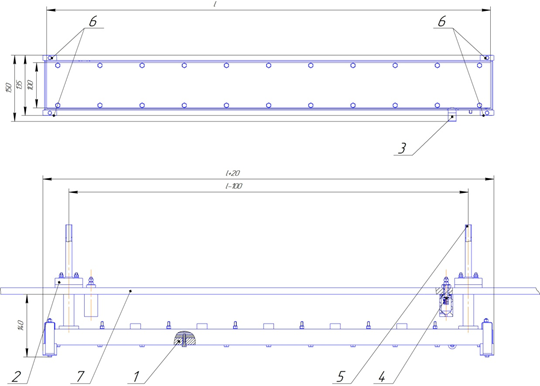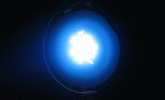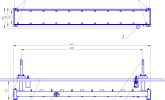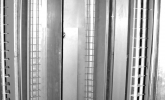- Home
- Technological sources
- Arc evaporator
Arc evaporator
Planar arc evaporator is designed for sputtering metallic, ceramic and composite coatings (thin films) in vacuum by arc spraying in vacuum systems.
Arc evaporator is widely used for the application of the following coatings:
- Metal: Ti, Cr, Zr, stainless steel.
- Ceramic: TiN, AlTiN, TixOy, AlTiSiN, TiCN, CrxNy and many others used as hardening, protective decorative, photocatalytic coatings (tools, dies, molds, furniture and door fittings, decorative ceramics)
- Application of solders (POS40), functional layers.
Fig. 1 shows a diagram of one version of an extended planar arc evaporator

Fig. 1 Planar arc evaporator diagram
1 – target (cathode), 2 – vacuum inlet, 3 – ignition, 4 – electrical lead-in, 5 – water inlet and high-current lead-in, 6 – end probes
The vacuum-arc evaporation process begins at a vacuum chamber pressure of 9х10-1 – 4х 10-2 Pa (7х10-3 – 3 ´ 10-4 mmHg) with the ignition of a vacuum arc (characterized by high current and low voltage), which forms on the surface of the cathode 1 (target) one or more point (in the size from units to tens of microns) emission zones (so-called “cathode spots”) in which all the discharge power is concentrated. The discharge is initiated by the ignition of pos. 5.
The local temperature of cathode spots is extremely high (about 15,000 °C), which causes intense evaporation and ionization of the cathode material in them and formation of high-velocity (up to 10 km/s) plasma flows propagating from the cathode spot to the surrounding space. A single cathode spot exists only for a very short period of time (microseconds), leaving a characteristic microcrater on the cathode surface, then its self-extinction and self-initiation of a new cathode spot in a new region on the cathode close to the previous crater occur. Visually it is perceived as moving the arc over the cathode surface.
Since an arc is essentially a current conductor, it can be influenced by the application of an electromagnetic field, which is used in practice to control the movement of the arc over the cathode surface, to ensure its uniform erosion.
In the vacuum arc, an extremely high power density is concentrated in the cathode spots, resulting in a high level of ionization (30–100%) of the plasma flows formed, consisting of multiply charged ions, neutral particles, clusters (macroparticles, droplets). If a chemically active gas is introduced into the vacuum chamber during the evaporation, its interaction with the plasma flow can lead to its dissociation, ionization and excitation, followed by the occurrence of plasma chemical reactions with the formation of new chemical compounds and their deposition in the form of a film (coating).
Characteristics of planar arc evaporators
|
No. |
Parameter |
Value |
|
1 2 3 4 |
Operating pressure, Pa Operating current, A Operating voltage, V Rate of deposition on a fixed substrate, copper, μm/min, not less than Lengths of targets of manufactured arc evaporators, mm |
from 0.01 up to 1.1 from 70 to 250 from 20 to 40 0.5 from 400 to 3000 |
The arc evaporator is structurally designed with cooling and power connections on the rear side (Fig. 1) and is connected to cooling and power supply sources with the use of tubes in insulation with the seal assemblies designed by the manufacturer.
Our planar evaporators have been tested by time and thousands of technological processes and are operated not only in Russia, but also in Spain, Kuwait, Hungary and other countries.
Interaction with customers begins with the selection of a technological source, the selection of additional options, advice with respect to the standard process modes, and continues to source servicing.
Advantages of our planar arc evaporators:
- We provide a planar arc evaporators model for design engineers and recommend the optimal target–substrate distance.
- High sputtering rate.
- High ionization degree of the sputtered material.
- High adhesion of coating.
- Reduced droplet phase due to cathode spot motion.
- Low cost of coating deposition.
- Good repeatability of coatings (no need for a plasma spectral monitoring device).
- High utilization rate of the target.
- Short lead times.
- Multi-stage quality control.
- Stable behaviour over time.
- Direct and indirect cooling of the target (cathode).
- Experience and professionalism of our team allows us not only to produce a standard series of arc evaporators, but also to conduct research and development of arc evaporators of various types and purposes. Currently, several projects are at the design and test stages:
- Round flat arc evaporator.
- Cylindrical high-current arc evaporator.
- Tubular extended arc evaporator.



